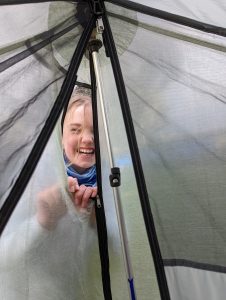Planning for long hikes when your pancreas doesn't work
Hiking with Type 1 diabetes means having to carry a bunch of additional equipment and putting additional precautions in place.
For day hikes or section hikes, this is normally pretty straightforward – insulin pens, a few spare vials of insulin, a blood glucose meter and some contingency food in case of a low blood sugar emergency (known as hypoglycemia or a 'hypo').
For these shorter hikes, the weight of diabetes equipment is not a major concern due to a generally much lighter pack and relatively short distances.
For an end to end hike, my diabetes gear is a key component of my gear as I cannot function without it. As such, the weight of it has to be accommodated creating another planning and logistics challenge.
Given I’m going fairly low tech with a blood glucose meter and insulin pens, I have to calculate how much insulin, test strips, needle caps, lancets, sanitizer and other consumables I will need. Importantly, I will need to keep my insulin cold while hiking so it remains effective.
The other critical component in diabetes management is food planning– how much food am I using to fuel myself, what kind of insulin regime will this require, how will my insulin receptivity respond to strenuous daily exercise and what is my contingency plan for hypos?
In the same way that Sim and I have approached every other aspect of planning for hiking the Heysen Trail, I spent time mapping out what I would need to manage my diabetes over the course of a 48 day through hike.
This is a tale of two parts.
Part 1 – Meal Planning
I’ve used my daily meal plan as a basis for calculating my diabetes management, taking into account the following considerations:
- At least 3500 calories/day – 2000 base + 1500 to accommodate physical activity.
- Low GI/higher carbohydrate food to mitigate blood sugar spikes.
- Food intake spread over five meals to mitigate blood sugar spikes and energy level ‘crash’.
- High calorie to weight efficiency while balancing nutritional advice for diabetics.
- Contingency for hypos if needed.
| Meal | Food | Calories | Weight |
| Breakfast | Fruit & Nut Muesli 120g/Powdered Milk 60g/Coffee 4g | 827 | 184g |
| Morning Snack | Homemade Trail Mix 75g | 288 | 75g |
| Lunch | Vita Weat 9 grain crackers x12100g chorizo or salami/Babybel mini x3or similar cheese/Peanut Butter | 1,315 | 290g |
| Afternoon Snack | Homemade Trail Mix 75g | 288 | 75g |
| Dinner | Dehydrated meal 165g/Olive oil 50ml | 1102 | 210g |
| Contingency | Muesli Bar (Carmen’s Fruit & Nut)x6/Glucojel Jelly Beans 70g (1 bag per resupply) | 1400 | 340g |
| TOTAL | 3,820 calories | 834g | |
| TOTAL w. Contingency | 5,220 calories | 1,174g |
The contingency food will also be scaled according to the number of days between our next town stop. At present it reflects the amount carried ahead of a 6 day stretch, which will be our longest period between resupply/town stop.

Part 2 – Diabetes Gear
In working out how much stuff I need to manage my diabetes I started with my usual daily insulin injection amounts while also taking into account the impact of exercise on my blood sugar levels.
I use quick acting Novorapid insulin during the day and slow release Protophane insulin to keep my blood sugar levels stable overnight. Both types of insulin come in 300 unit vials.
I calculate how much insulin I need by firstly testing my blood sugar levels by pricking my finger and testing my blood via a test strip with my meter, and then injecting however many units of insulin would be required to maintain my blood sugar at an optimal level based on the reading it gives me.
I’ve broken my insulin usage down below, using my past experiences as a guide. This will likely change once my body adjusts to the meal and exercise regime:
| Meal | Units of insulin |
| Breakfast | 40 Novorapid |
| Morning Tea | 15 Novorapid |
| Lunch | 20 Novorapid |
| Afternoon Tea | 15 Novorapid |
| Dinner | 35 Novorapid |
| Overnight | 15 Protophane |
This gives me a daily insulin use rate of:
- 125 units of Novorapid; and
- 15 units of Protophane.
Given one vial of insulin holds 300 units, my use rate per vial is:
- 1 vial of Novorapid every 2.4 days.
- 1 vial of Protophane every 20 days.
We will be hiking for 48 days and I believe good risk management will be to take a conservative approach to usage and build in some redundancy. This will also allow for variables like cracked vials or a variance in my actual use rate.
On that basis, I’ve made my calculations on using one 300 unit vial every 2 days. Over the 48 days of the hike this means I will need to bring 24 vials of Novorapid – this is about what I use on a 1.5 month basis ordinarily. I will round this up to 25 vials.
Protophane has a consistent use rate and over the course of the hike I will require 720 units and I will only have to bring 3 vials.
I also need to bring enough test strips to meet my daily needs. I’m assuming I’ll use 7 test strips a day, recognising that I’ll need to keep closer tabs on my blood sugar levels. Over 48 days, this means I’ll need 336 strips. Building for redundancy again, I will round this up to an even 350.
In addition, I’ll need spare needle caps, lancets, a sharps container and a cooling case to keep my insulin cold.
Taking into account my full array of gear I need and how much it will add to my overall pack weight, I’ve broken it down as follows:
| Type | Weight |
| Insulin vials x28 | 249g |
| Blood Glucose Meter (Optium Freestyle Lite) + Case | 79g |
| Injection Pens + Case | 157g |
| Test strips | 42g |
| Frio Cold Case | 177g |
| Needle caps | 30g |
| Lancets | 10g |
| Mini Sharps container | 22g |
| TOTAL | 766g |
This is a considerable amount of weight and I will be actively looking for ways to reduce it. My immediate thoughts are to remove any unnecessary cases or containers in favour of lighter options - I’ll do this as part of trimming my overall pack weight and finalising my gear loadout.
As we’re passing through towns over the course of the trek, there will be opportunities to dispose of sharps at the local chemist and to pick up additional consumables if needed. Setting it out ahead of time like this, however, provides me with peace of mind and will reduce some of the diabetes-related worry while I’m out there.
Diabetes SA is an incredible source of knowledge and information and I intend to run this thinking past them prior to setting off.
I’m particularly keen to get feedback on my meal planning to make sure it accords with good practice and any suggestions on how it could be improved.
I’m incredibly grateful to Diabetes SA for their support in preparing for this trek and really want to highlight the quality of advice, service and support they provide to diabetics, their families and the broader community.


